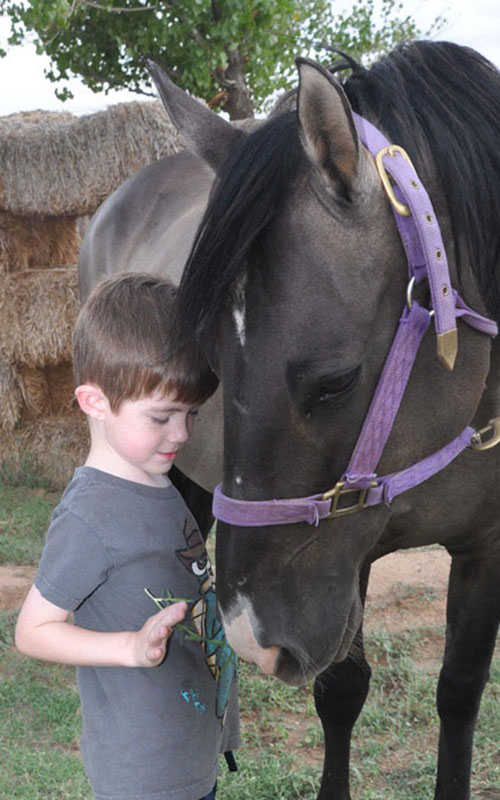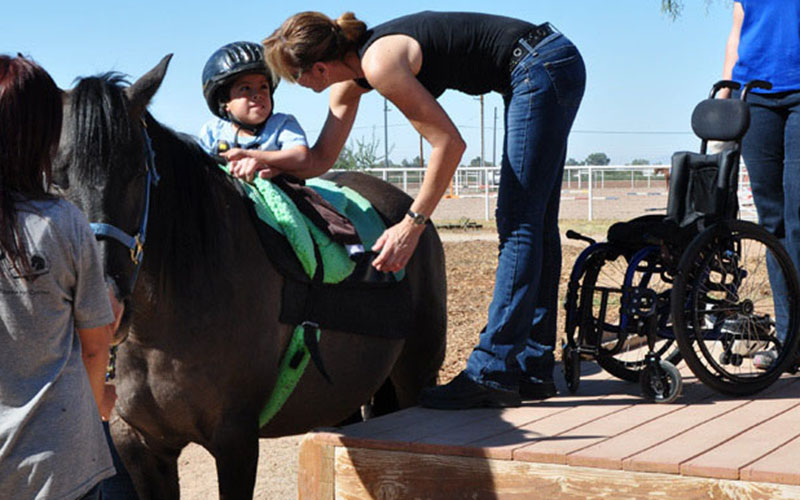SAN TAN VALLEY – For years, Steven O’Shaughnessy didn’t speak. His mother took him to one medical expert after another. Still, he didn’t talk.
Then, his mother took him to meet Pace, a therapy horse at Hoofbeats With Heart.
“I was told that if he didn’t talk by six that he would never talk,” Susan O’Shaughnessy said of her son, who has autism. “Steven was seven when we started at Hoofbeats, and two years into the program he started talking.”
O’Shaughnessy has three other children, all with disabilities. All four children improved significantly because of equine therapy.
“My oldest has the most severe autism, and he started talking shortly after starting the program,” O’Shaughnessy said. “And my youngest, who is the lowest-functioning, would never throw a ball until he got on the back of a horse.”

Steven O’Shaughnessey spends time with his therapy horse Pace at Hoofbeats With Heart. (Photo courtesy Kelley Hullihen/Hoofbeats With Heart)
O’Shaughnessy and her family said the connection with horses is key.
“We’re doing physical therapy at home right now and it’s not going well, nowhere near as well as it went with the horses,” O’Shaughnessy said. “Riding horses gives them the sensory input they need, and the biggest factor is that connection.”
Equine therapy programs have helped people like the O’Shaughnessy family and are growing in Arizona and across the country, with about 62,000 attending such centers in the U.S. in 2015. The programs are geared for children and adults with physical and mental disabilities, veterans and the elderly.
In Arizona, about a dozen centers offers services such as hippotherapy, which is certified therapy on the back of a horse, therapeutic riding, which is individual riding lessons and equine psychotherapy, where clients help to care for the horses by grooming them, walking them and other tasks.
Federal funding is hard to come by for equine therapy, which is an expensive operation for owners of the businesses.
The centers, which rely on health-insurance reimbursements, grants and donations, often struggle to stay afloat. Several Arizona organizations cobble together different funding mechanisms to stay in business: relying mostly on insurance reimbursement, combining reimbursements and family “donations” or mainly relying on donations and grants.
Private groups such as the Horses and Human Research Foundation provided more than $170,000 in grants to equine non-profits and research, according to its 2015 annual finance summary. That’s a $50,000 increase over the previous year.
Insurance reimbursement
Hoofbeats, founded in 2006, depends on insurance reimbursements to operate its programs.
Kelly Hullihen, founder and owner, said she has put $1 million of her own money over a decade to keep offering the services to families.
“I try to service as many people as possible,” Hullihen said. “Those who need the help and the guidance are more than welcome. We don’t turn anybody away here.”
The ranch has gone from three therapists to about 20 therapists and a dozen therapy horses, serving from 150 to 200 students at a time.
It’s not cheap to run the ranch. Hullihen said it costs about $14,000 per month to pay for horses and the office and barn staff.
None of it comes from government funding. Instead, at least half comes from billing insurers for services to clients.
“Government funding is little to non-existent in the equine therapy world and grants and donations really make up for what we lack from agencies,” Hullihen said. That means she can offer full or partial scholarships to families that can’t afford to pay for therapy.
Gina Kraus, equine director, said grants and donations bring in the rest of the money to operate the center. Sometimes, families are asked for a “donation” for certain services but it is not required.
The center has about $50,000 in reserves, leaving it in a comfortable financial space, Hullihen said.
Types of treatment
Debt free
Scottsdale’s Camelot Therapeutic Horsemanship builds its operation on private donations and grants, serving about 25 students at a time. Families are not charged directly or through insurance, according to executive director Mary Hadsall.
Hadsall is proud the organization is debt free.
Hadsall said the farm holds two annual fundraisers that account for about 40 percent of its annual operating income. Camelot currently houses nine horses, with 25 students and five full-time staff members.
“There’s no pricetag on what we teach, but I do have expectations from every student,” Hadsall said. “It’s not a free ride.” Because Camelot does not have certified therapists on staff, no insurance agencies or families are charged. But Hadsall does expect students to show up on time, be dedicated and appreciate their horses.
(Video by Kaddie Stephens/Cronkite News)
Camelot has more than enough reserves in place, and the ranch is operating smoothly and efficiently, she said.
Hadsall said Camelot recently received two large donations of materials for a covered arena to allow riding in all types of weather, and a wheelchair accessible ramp and lift, allowing wheelchair-bound riders to mount horses on their own.
“Life with a disability is very expensive, and the students who are participating here wouldn’t have this opportunity if we were charging for our services,” Hadsall said.
Lesson fees
Horses Help has a pay-as-you-go financial model, with families paying a fee for each lesson.
The Cave Creek business houses about 20 horses for more than 100 clients each week. The family fee covers about one-third of the organization’s cost to put a student in the saddle. The rest, like most organizations, comes from donations and private grants, according to program director Saebra Pipoly.
Horses Help does not charge clients through insurance reimbursements but certified therapists can do so. In that case, the therapist initiates the reimbursement.
Horses Help is on the edge financially for several months a year, she said. It costs about $2,500 for basic care for each animal. She and the staff wait anxiously for grant money to arrive in April.
“We would like to get to where we’re a little bit less reliant on grants,” Pipoly said. “We want to stay an affordable activity for the special needs community but we also want to be able to fund ourselves in case something extreme were to happen.”



